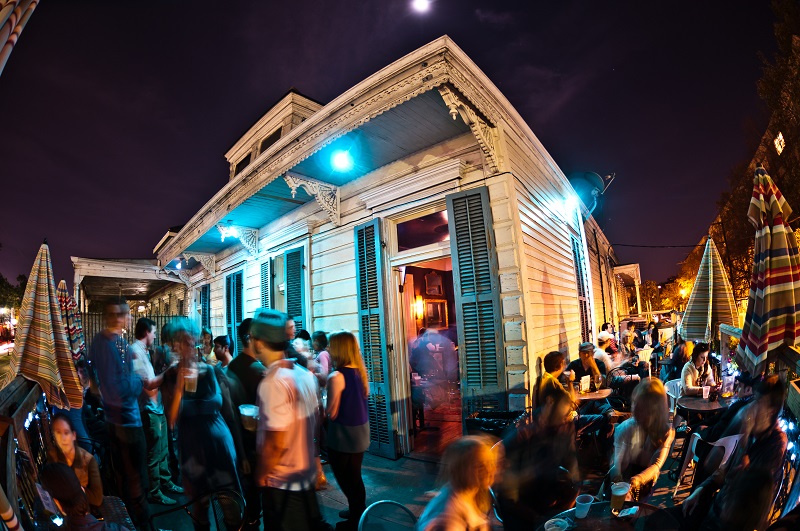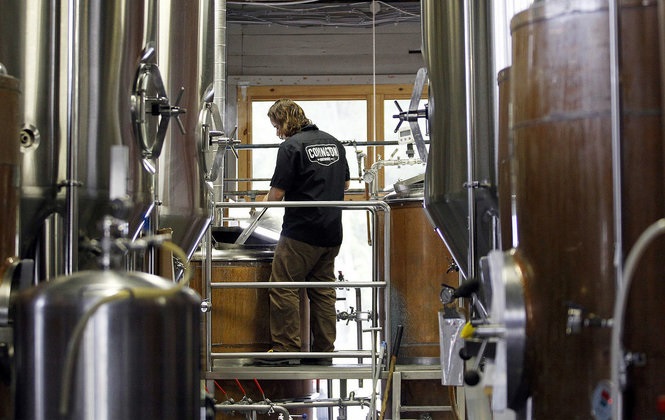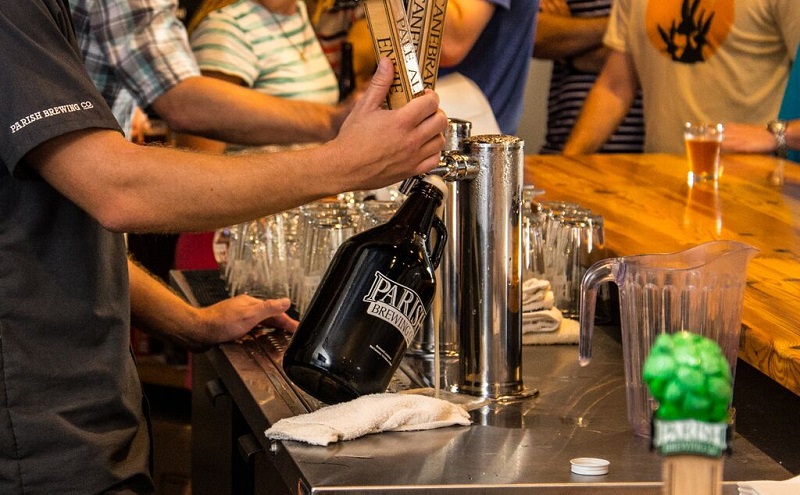New Orleans: Once Hard, Now Easier
Finding Beer In And Around The Crescent City
There are many theories for why a city as thoroughly marinated in booze as New Orleans has been slow to embrace the modern beer movement: Kafkaesque local zoning obstacles, inconsistent state regulations or just a hot-weather palate that appreciates a lighter style of beer.
This party town loves a good time with its frozen daiquiris sold at drive-thru windows (which always hit the spot on a hot and humid summer night), the rum-based Hurricane and the neon-green Hand Grenades found on Bourbon Street. Drinking in the street between bars and parties is no problem as long as it’s not in a glass container—have go-cup, will travel.
Beer has historically been barely a second thought: something light for taking it easy, day drinking, tailgating, parades and to temper the heat of the locally loved crawfish boil. Louisianians seemed often to use beer to take the place of water for thirst-quenching purposes, and the light lager style and lack of flavor in the beer most frequently imbibed reflected that all too well.
But more and more people in New Orleans and Louisiana, with their well-evolved palates for food, wine, and cocktails, are understanding how beer can have flavor and complement local ingredients and add to the pleasure of dining and drinking. Over the past 10 years, the proverbial streetcar has finally left the station, and local beer options are popping up at an exponential rate.
In pre-Prohibition days, New Orleans was considered to be the brewing capital of the South, with its rich German immigrant brewing traditions and status as a major port city. The evidence is all over the city, like the old Jax Brewing building overlooking the Mississippi River in the French Quarter, the old Falstaff Beer brewery (which has been converted into apartments) and the Dixie logo painted on the side of venerable music club Tipitina’s. Dozens of breweries sprang up in the city between 1845 and 1920, but as in so many other cities, Prohibition and brewery consolidation chipped away at the numbers. By the late ’70s-early ’80s, brewing culture was all but lost in New Orleans.
In 1986, the Abita Brewing Co. opened in a tiny town located to the north of the city, way across Lake Pontchartrain. In 1991, Wolfram “Wolf” Koehler opened up Crescent City Brew-house in the French Quarter. Koehler says of his decision, “A lack of good beer in New Orleans seemed to be a perfect invitation for a German brewmaster looking for a place to put a brewery.”
A New Orleans outpost of the Gordon Biersch family of brewpubs opened next to the Harrah’s Casino in 2004.
In August 2005, Hurricane Katrina hit, the levees fell, and the entire city of New Orleans had a demarcation line of what life was like “before” and “after.” The entrepreneurial spirit that led to the rebuilding of homes and structures also gave birth to looking at the culture in a new way, in order to make it not only what it was “before,” but to make it even better.
In the Wake of the Storm
When Kirk Coco retired from the U.S. Navy to help rebuild his native city, he recalls putting in a hard day’s work and reaching for a Dixie, what he thought was a local beer. However, he read on the label that it was contract-brewed in Wisconsin. Dixie Brewing Co. had closed in 2005, in the months just before Katrina, and had switched to contract brewing.
“It baffled me that there was no brewery here,” he says. “It just made no sense.”
He decided to start NOLA Brewing, the first post-Katrina production brewery in New Orleans. Coco didn’t brew, however, which led him to Peter Caddoo.
Caddoo, who trained at the Culinary Institute of America, was a chef who worked at the Creole restaurant Commander’s Palace under Emeril Lagasse before he quit in order to become a brewer at Dixie. After the storm, Caddoo was back in the culinary world when Coco approached him to be brewmaster at NOLA.
In 2009, Coco and Caddoo were ready to start selling their beer, and one of the first stops was the Avenue Pub, a nearby 24-hour dive bar that had just started dabbling in offering brands like Rogue Ales and Brooklyn Brewery.
According to owner Polly Watts, her distributor told her that there was a new brewery in town and suggested she save a couple of taps for its beer.
Watts recalls, “He told me that it’s going to be a higher price point, probably selling for $5 a pint. And I said, ‘Five dollars for a blond ale? No one’s going to pay that.’ ”
“Then the beer comes out, and we tap one keg of NOLA Blonde and one keg of NOLA Brown. It was gone in like two hours. So I think it’s a fluke, just because nobody else in town has it on tap. So I order two more the next day. Gone in another two hours.”
“I think we were very fortunate to have Polly at the time when we were starting,” Coco says. “Because, if not, I don’t know if our brand could be what it is right now, without her educating the beer drinkers in the city and bringing all the other bars to a higher level. The other bars, they were good, but when Polly came, they were better.”
A Brewing Revival
Between 2005 and 2010, things started to change, not just inside the city, but in the surrounding areas as well. Bayou Teche Brewing and Parish Brewing opened to the west of New Orleans in the culturally rich Cajun country near the city of Lafayette. Covington Brewhouse, which had been brewing just down the road from its north shore neighbor Abita under a different name and brewmaster since 2005, expanded and rebranded.
Starting in 2010, the breweries began opening more quickly: Tin Roof in Baton Rouge, the state’s capital; Chafunkta Brewing and the Old Rail Brewing Co. brewpub in Mandeville, right on the shores of Lake Pontchartrain across from New Orleans; 40 Arpent Brewing just across the Orleans Parish border in Arabi; and Gnarly Barley Brewing, to the northwest of New Orleans in Hammond, between Lake Pont-chartrain and Baton Rouge.
It’s impossible to talk about the creation of beer culture in New Orleans without also mentioning Dan Stein of Stein’s Market and Deli. Stein opened his uptown Jewish deli in 2007 and subsequently began stocking an extensive and esoteric beer selection and hosting style-focused beer education classes—on seasonals or sours, for example—for both beginners and experts.
Recent Surge of Growth
With all the growth in the outlining areas, it wasn’t until 2014 that the Big Easy’s second production brewery opened. Courtyard Brewing is a nanobrewery where owner-brewer Scott Wood serves his beer alongside guest taps.
Working with the city to get his little brewery up and running, Wood remembers butting heads over the architectural plans with city employees.
“They said, ‘Who is going to want to come to a desolated warehouse to stand around and drink beer?’ I told them, ‘Lots of people. Beer geeks. Trust me.’”
Wood’s brewery is in half a small warehouse space with a bar made of salvaged wood, with concrete floors below and exposed ceiling pipes and wires above. A record player sits on the far end of the bar, and patrons are invited to bring their albums to share while drinking Wood’s hop-forward and Belgian-style beer. There isn’t any regular seating, but folding chairs can be deployed to set up impromptu groupings around makeshift tables—repurposed cable and wire spindles—both inside and out. The outdoor courtyard is adorned with twinkling white strings of lights, and most days a food truck is parked right next to it.
Wood couldn’t make enough beer on his three-barrel system to satiate the local demand. He’s just added three new tanks to increase his production, but in less than a year after opening, the business has surpassed all expectations and projections he and his wife (and business partner), Lindsay Hellwig, had anticipated.
Beer bar Snooty Cooter also opened in 2014, in the back bar of the oyster-shucking sports bar Cooter Brown’s. Cooter Brown’s has been known for its many beer taps of imports and lagers like Newcastle Brown Ale, Stella Artois, Guinness, Pabst Blue Ribbon, and Abita’s famous Amber, for almost 40 years, but the selection was more geared to football fans than discerning beer drinkers. Cooter Brown’s owner Larry Berestitzky and general manager Jonathan Junca sought to change that perception and opened The Snooty Cooter, a small beer bar within a sports bar, tucked in back like a secret speak-easy, symbolizing new trends within old traditions, and speaking to the change in attitudes about beer in New Orleans. Now, its 46 taps dispense Belgian beer, local rarities and specialty beers from all over the country.
Local restaurants have recognized the flavor profile potential and have been expanding their beer lists: Nathanial Zimet’s Boucherie restaurant has been ahead of the beer curve for years, having hosted a Brooklyn Brewery beer dinner with Garrett Oliver in 2010, well before such a concept was even on the radar of other chefs or beer professionals.
The restaurants in local superstar chef John Besh’s New Orleans empire are also forward thinking in combining beer and food. Besh’s flagship, Restaurant August, offers a well-thought-out, food-friendly bottled beer list. Downtown seafood restaurant Borgne, also owned by Besh, also carries a large selection of beer on draft and in cans. In addition, the John Besh Foundation has paired with a Louisiana brewery, Great Raft Brewing, to explore the relationship between cooking and brewing by having its chefs work with the brewer to create four unique beers.
As Crescent City Brewhouse’s Koehler says, “for us to have a brewery in the French Quarter was like a dream come true, because all the other ingredients that I like about a city are here—the good food, music, architecture, the people, the Mardi Gras, you name it. It had everything except the brewery. You know, New Orleans used to have 22 breweries at the turn of the last century. Maybe by the turn of this century, we’ll have 22 breweries again.”




You did not mention DBA on Frenchman street. While it’s not a brewery, it’s a great place to drink craft beer. They have a great selection of spirits too.